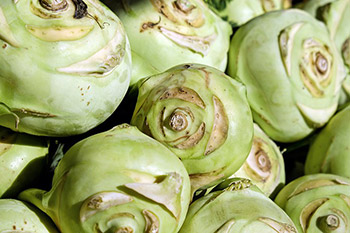Kohlrabi, also known as knol-khol or German Turnip, is a stout, round, tuberous vegetable in the Brassica family. It’s native to Europe and the temperate climates worldwide for its succulent round shaped modified stem as well for its turnip-flavored top greens. Some of the popular cultivars grown worldwide are white Vienna, white Danube, purple Vienna, and grand duke.
It requires well-drained fertile soil and average sunlight to thrive. Its edible stem attains maturity and ready for harvest in 55-60 days after sowing.
The approximate weight is 150 g. Unlike turnip which is a root vegetable, kohlrabi being a stem vegetable has less propensity to cracking and has a good standing ability for up to 30 days even after maturity.
Health benefits of Kohlrabi (Knol-khol)
Kohlrabi is healthy for you- it has only 27 calories per 100 grams, and negligible amounts of fat and cholesterol. The vitamins and minerals in kohlrabi are very nutritious as well. The leaves or tops, like turnip greens, are also quite nutritious.
If you’re trying to find a healthier take on dinner, then you want to try some fresh kohlrabi, which has only 27 calories per 100 g, 7 grams of fat, and no cholesterol. It doesn’t contain high levels of saturated fat or sodium, but it does have plenty of potassium and vitamin-C. Fresh stem is high in vitamin-C; contains an impressive 62 mg per 100 g weight that is about 101% of RDA.
Vitamin-C (ascorbic acid) is a powerful antioxidant that helps the body maintain healthy connective tissue and teeth, among other needed benefits.
To top it all off, our authentic kohlrabi chunks have both bisulfide sulfur compounds called ascorbyl esters for better taste plus phytochemicals including sulforaphane, indole-3-carbinol, and other health-promoting nutrients such as glucosinolates.
Selection and storage
The best time to enjoy these potatoes is during winter from November to March when they are most plentiful.
Overmaturation and exposure to intense sunlight reduces their culinary quality. Look for fresh kohlrabies that can crunch on your bite and have a tasty flavor.
The store will have tubers of medium size, with good texture, sans cracks or cuts. If a hand feels too light when carrying tubers, or if it has an excessively woody texture, avoid buying them as they display signs of overmaturation which spells unappetizing.
This tuber also has good keeping qualities, so you can place them at room temperature for three to five days without refrigerating in case you’ll be storing them for some more time too.
Preparation and serving methods
Kohlrabi should be washed thoroughly in clean running water and swished in saline water for about 10-15 minutes to remove any surface soil, dirt, and any insecticide/fungicide residues.
Just before cooking, you can remove any leaves and trim the stem ends. Peel the skin using a paring knife. Kohlrabi is typically mixed with other vegetables or greens in recipes like empanadas or stewed with onion, garlic, and tomato.
Safety profile
Kohlrabi may unexpectedly contain plant-based compounds that can cause swelling in the thyroid gland and should be avoided in individuals with thyroid dysfunction. However, a healthy person can eat them liberally (without risk).










![Is Tokyo Ghoul on Netflix? [How to Watch Online]](https://avctv.com/wp-content/uploads/2022/08/AAAABct1DaUzhEt4JeJFeDrmaE_4CGAu39fBN6poMx10hAlWlMRjkkAw84hjmuujWTy2wFC7_Pjnujec-_PqT1GCnnMFMJ15S04baJn1b0WvvbG6hrSNb31_GS4--120x86.jpg)





